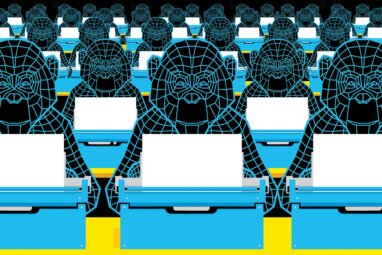1. C.B. Frey and M.A. Osborne, “The Future of Employment: How Susceptible Are Jobs to Computerisation?” Technological Forecasting and Social Change 114 (January 2017): 254-280.
2. S.K. Parker and G. Grote, “Automation, Algorithms, and Beyond: Why Work Design Matters More Than Ever in a Digital World,” Applied Psychology, Feb. 13, 2020, https://doi.org/10.1111/apps.12241.
3. C.P. Cerasoli, G.M. Alliger, J.S. Donsbach, et al., “Antecedents and Outcomes of Informal Learning Behaviors: A Meta-Analysis,” Journal of Business and Psychology 33, no. 2 (April 2018): 203-230; and J.A. Carpini, S.K. Parker, and M.A. Griffin, “A Look Back and a Leap Forward: A Review and Synthesis of the Individual Work Performance Literature,” Academy of Management Annals 11, no. 2 (June 2017): 825-885.
4. S.K. Parker, M.K. Ward, and G.G. Fisher, “Can High-Quality Jobs Help Workers Learn New Tricks? A Multi-Disciplinary Review of Work Design for Cognition,” Academy of Management Annals 15, no. 2 (July 2021): 406-454.
5. S.K. Parker, “Beyond Motivation: Job and Work Design for Development, Health, Ambidexterity, and More,” Annual Review of Psychology 65 (2014): 661-691.
6. J.L. Horn and R.B. Cattell, “Age Differences in Fluid and Crystallized Intelligence,” Acta Psychologica 26 (1967): 107-129.
7. R.B. Cattell, ed., “Intelligence: Its Structure, Growth and Action (Amsterdam: Elsevier, 1987).
8. E. Demerouti, A.B. Bakker, F. Nachreiner, et al., “The Job Demands-Resources Model of Burnout,” Journal of Applied Psychology 86, no. 3 (June 2001): 501.
9. T.D. Wall, J.M. Corbett, R. Martin, et al., “Advanced Manufacturing Technology, Work Design, and Performance: A Change Study,” Journal of Applied Psychology 75, no. 6 (December 1990): 691.
10. N.B. Sarter, D.D. Woods, and C.E. Billings, “Automation Surprises,” in “Handbook of Human Factors and Ergonomics,” 2nd ed., ed. G. Galvendy (New York: John Wiley & Sons, 1997), 1926-1943.
11. Cerasoli et al., “Antecedents and Outcomes,” 203-230.
12. A.N. Kluger and A. DeNisi, “The Effects of Feedback Interventions on Performance: A Historical Review, a Meta-Analysis, and a Preliminary Feedback Intervention Theory,” Psychological Bulletin 119, no. 2 (March 1996): 254-284.
13. L.A. Steelman, P.E. Levy, and A.F. Snell, “The Feedback Environment Scale: Construct Definition, Measurement, and Validation,” Educational and Psychological Measurement 64, no. 1 (February 2004): 165-184.
14. G.S. Shields, M.A. Sazma, A.M. McCullough, et al., “The Effects of Acute Stress on Episodic Memory: A Meta-Analysis and Integrative Review,” Psychological Bulletin 143, no. 6 (April 2017): 636.
15. C.L. Porath and A. Gerbasi, “Does Civility Pay?” Organizational Dynamics 44, no. 4 (October-December 2015): 281-286.
16. T.A. Salthouse, “Mental Exercise and Mental Aging: Evaluating the Validity of the ‘Use It or Lose It’ Hypothesis,” Perspectives on Psychological Science 1, no. 1 (March 2006): 68-87; and Y. Stern, “Cognitive Reserve in Ageing and Alzheimer’s Disease,” The Lancet Neurology 11, no. 11 (November 2012): 1006-1012.
17. G.G. Fisher, A. Stachowski, F.J. Infurna, et al., “Mental Work Demands, Retirement, and Longitudinal Trajectories of Cognitive Functioning,” Journal of Occupational Health Psychology 19, no. 2 (April 2014): 231.
18. K.Y. Pan, W. Xu, F. Mangialasche, et al., “Working Life Psychosocial Conditions in Relation to Late-Life Cognitive Decline: A Population-Based Cohort Study,” Journal of Alzheimer’s Disease 67, no. 1 (2019): 315-325.
19. T.W.H. Ng and D.C. Feldman, “The Relationship of Age to Ten Dimensions of Job Performance,” Journal of Applied Psychology 93, no. 2 (March 2008): 392.
20. R. Andel, M. Crowe, E.A. Hahn, et al., “Work-Related Stress May Increase the Risk of Vascular Dementia,” Journal of the American Geriatrics Society 60, no. 1 (January 2012): 60-67.
21. A. Parent-Thirion, I. Biletta, J. Cabrita, et al., “6th European Working Conditions Survey: 2017 Update,” PDF file (Luxembourg: European Foundation for the Improvement of Living and Working Conditions, 2017), www.eurofound.europa.eu.
22. J. Rothwell and S. Crabtree, “How COVID-19 Affected the Quality of Work” (Washington, D.C.: Gallup, 2020).
23. S.K. Parker, D.M. Andrei, and A. Van den Broeck, “Poor Work Design Begets Poor Work Design: Capacity and Willingness Antecedents of Individual Work Design Behavior,” Journal of Applied Psychology 104, no. 7 (July 2019): 907.
24. The SMART model is based on S.K. Parker and C. Knight’s “A Higher-Order Analysis of Work Design Characteristics,” which is currently under review. Practical information about the model is available at www.smartworkdesign.com.au.
25. C. Knight and S.K. Parker, “How Work Redesign Interventions Affect Performance: An Evidence-Based Model From a Systematic Review,” Human Relations 74, no. 1 (January 2021): 69-104.
26. M. Tims, A.B. Bakker, and D. Derks, “Development and Validation of the Job Crafting Scale,” Journal of Vocational Behavior 80, no. 1 (February 2012): 173-186.
27. S. O’Mahony and B.A. Bechky, “Stretchwork: Managing the Career Progression Paradox in External Labor Markets,” Academy of Management Journal 49, no. 5 (October 2006): 918-941.
i. X. Parent-Rocheleau and S.K. Parker, “Algorithms as Work Designers: How Algorithmic Management Influences the Design of Jobs,” Human Resource Management Review, May 10, 2021, https://doi.org/10.1016/j.hrmr.2021.100838.






Comments (4)
pedro gavides
John wilson
Edwin Weckend
Joelle Bixby